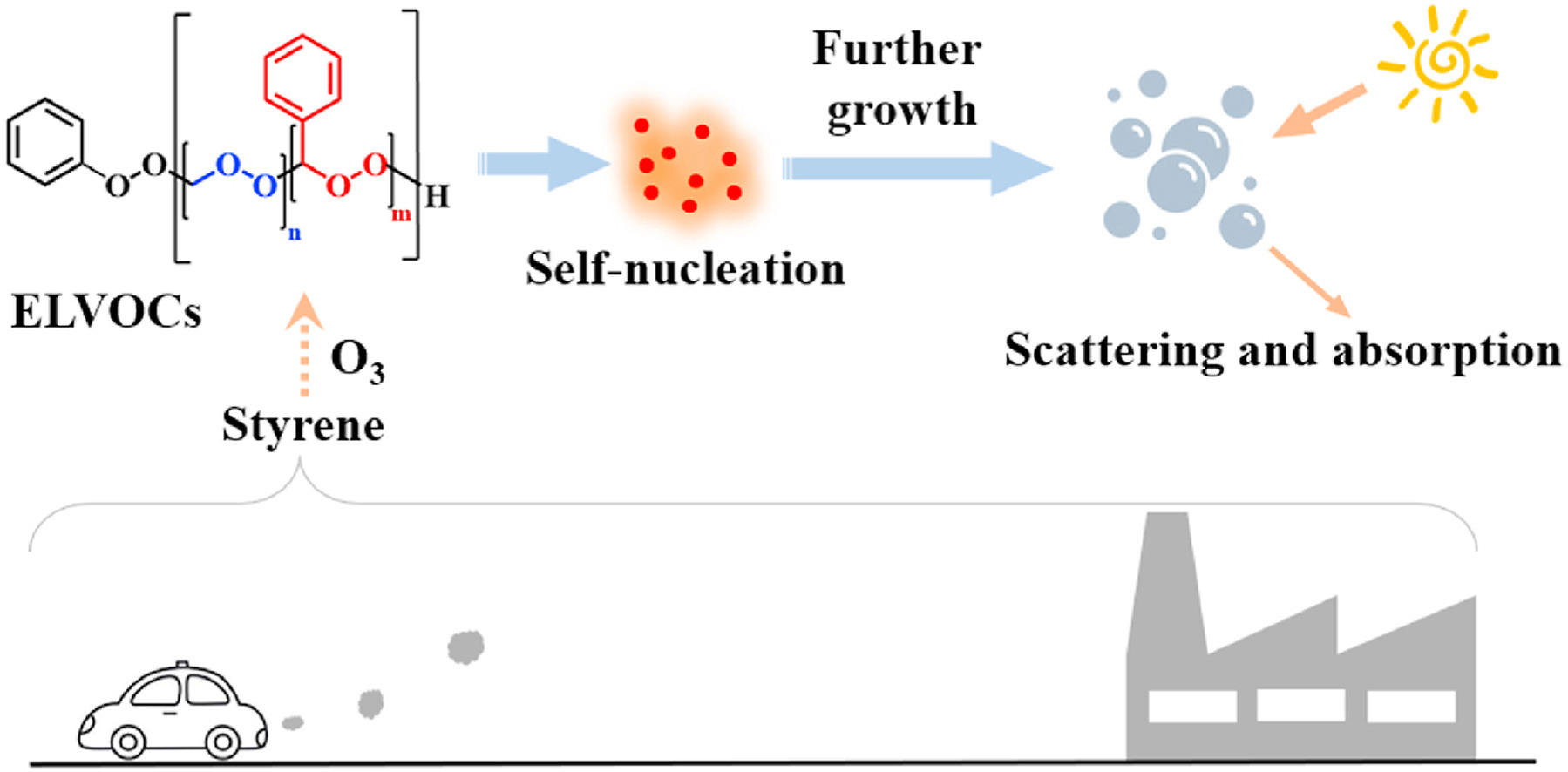组内消息
2024-04-08

二次有机气溶胶(SOA)是大气细颗粒物的重要组成部分,会对环境、气候和人体健康产生影响。苯乙烯(styrene)和异戊二烯(isoprene)是人为和自然源SOA的重要前体物,在大气环境中广泛存在,但它们间的交叉反应并未受到关注。课题组基于烟雾箱模拟实验和高分辨轨道阱质谱技术(Orbitrap MS),研究了由苯乙烯和异戊二烯产生的克氏自由基中间体(Criegee SCIs)之间的交叉反应,以及交叉反应对SOA的形成和物理化学性质的影响规律。发现来自苯乙烯的特征C7-SCI和异戊二烯的特征C4-SCI可以发生交叉反应,并导致混合体系的SOA产率低于单一苯乙烯-O3体系,但高于单一异戊二烯-O3体系。同时在外场环境采集的细颗粒物中也发现了SCI相关的交叉产物。该研究证实SCI在决定苯乙烯-异戊二烯混合体系SOA的生成和理化性质方面的起着关键作用,说明在城市环境中,人为和自然源挥发性有机化合物(VOCs)的相互作用会显著改变SOA的理化性质,突显了交叉反应的重要性。
Yu, S.S., Jia, L.*, Xu, Y.F., Pan, Y.P., 2024. Oligomer formation from cross-reaction of Criegee intermediates in the styrene-isoprene-O3 mixed system. Chemosphere, 349, 140811, https://doi.org/10.1016/j.chemosphere.2023.140811
组内消息
2023-01-20

在我国秋冬季节,雾霾事件时有发生。二次有机气溶胶(SOA)对雾霾有重要贡献,然而SOA与雾(或云)之间的基本相互作用还知之甚少,主要原因包括:(1)与无机盐不同,SOA主要由半挥发或中等挥发的有机气体通过气-粒转化形成,这意味着SOA的吸湿性(或活化为云雾滴的能力)不仅取决于颗粒态有机分子,同时还受SOA气态前体物的影响;(2)SOA组成和形成机理的复杂性,SOA由成千上万种有机分子组成,其来源不仅包括各种气相反应,而且还包含了大量颗粒相反应;(3)外场观测中通常采用热力学模型(例如,ISORROPIA或E-AIM)估算颗粒水含量,但其往往忽视了有机气溶胶对颗粒水的贡献;(4)要揭示SOA-雾相互作用,还需要精细化的气溶胶动力学模式与云雾微物理过程进行耦合,而在线耦合数千反应和数百个物种的大气化学动力学过程与云雾的微物理过程是一项挑战性任务。

中国科学院大气物理研究所贾龙副研究员及其合作者(徐永福和段民征研究员)通过高分辨质谱技术和精细化的气溶胶动力学模式(CSVA),在深入解析甲苯气态和颗粒态分子的基础上,从云雾微物理角度解析了SOA与云雾之间的相互作用,并首次发现气溶胶-雾相互作用是导致的SOA爆发性增长的关键机制。即,霾(haze)与雾(fog)紧密交织在一起,一方面,水溶性气态有机物的存在会降低SOA活化为云雾滴的临界过饱和比,导致SOA在湿度接近或低于100%时即可活化为云雾滴;同时,云雾的生成进一步促进水溶性气态有机物的气-粒转化,从而导致了SOA的爆发式增长。还进一步分析了温度和相对湿度在SOA生成中的协同作用,发现低温可以显著放大有机气体对SOA爆发式增长和云凝结核活化的作用。上述结果表明云雾微物理过程是水溶性气态有机物快速转化为二次有机气溶胶的主要原因。
Jia, L., Xu, Y., Duan, M., 2023. Explosive formation of secondary organic aerosol due to aerosol-fog interactions. Sci. Total Environ. 866, 161338. https://doi.org/10.1016/j.scitotenv.2022.161338
组内消息
2022-07-01
苯乙烯是城市大气中二次有机气溶胶(SOA)的重要前体物。由于苯乙烯具有芳香烃和烯烃的双重属性,因此作为一种重要的基础化工原料被广泛用于合成树脂和橡胶,从而导致苯乙烯具有广泛的人为排放源。以往研究发现苯乙烯具有很高的SOA生成潜势,但是缺少对苯乙烯SOA化学组成的了解。
最近,中国科学院大气物理研究所于姗杉博士和贾龙副研究员等结合自助开发的电离源和轨道阱质谱技术,首次从分子水平揭示了苯乙烯生成的二次有机颗粒物的化学组成(图1)。发现苯乙烯与臭氧反应可以生成一类分子量高达700Da的大分子聚合物。这类聚合物的挥发性极低,一旦在气相生成便可以单独成核。通过解析分子结构,发现Criegee自由基是此类聚合物生成的关键中间物质,并通过实验证实水汽对Criegee聚合反应具有抑制作用。
一般认为气态硫酸是大气中主要的成核物质,不过,实验室关于硫酸成核的研究与外场观测到的现象并不一致。如,外场观测到的成核过程与相对湿度呈负相关性,但实验室研究发现水汽对硫酸成核却具有促进作用。水汽对苯乙烯成核的抑制作用可以很好的解释这一下现象。同时也在外场颗粒物中发现了源自苯乙烯的聚合物,从而证实苯乙烯是大气中潜在的成核物质(图2)。由于苯乙烯在城市地区具有较高的浓度,因此苯乙烯对大气成核的贡献不容忽视。相关结果发表在Chemosphere和 Atmospheric Research上。

图1 相对湿度对苯乙烯氧化产物的影响机制

图2 苯乙烯与臭氧反应生成的大分子聚合物是重要的成核物质
Yu, S.S., Jia, L.*, Xu, Y.F., Pan, Y.P., 2022. Formation of extremely low-volatility organic compounds from styrene ozonolysis: Implication for nucleation. Chemosphere 305, 135459. https://doi.org/10.1016/j.chemosphere.2022.135459
Yu, S.S., Jia, L.*, Xu, Y.F., Pan, Y.P., 2022. Molecular composition of secondary organic aerosol from styrene under different NOx and humidity conditions. Atmospheric Research. 266, 105950. https://doi.org/10.1016/j.atmosres.2021.105950
- « PREV
- 1
- 2
- 3
- 4
- 5
- 6
- ...
- 18
- NEXT »









